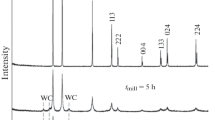Conclusions
Judged by the character of their elastic strain, zirconium and titanium carbides may be regarded as elastically isotropic materials. Under conditions of vibratory milling the main cleavage planes in these carbides are the planes {110}. Carbides of nonstoichiometric compositions are more brittle. The changes in strain behavior exhibited by the carbides in their homogeneity ranges are determined by the combined operation of the structural and electronic factors. In the Group IV carbides these two factors have opposed effects, but in Group V carbides they operate in the same direction. Arranged in order of increasing brittleness, on the basis of microplasticity as measured by rms strain, stoichiometric carbides form the series NbC < ZrC < TiC.
Similar content being viewed by others
Literature cited
S. S. Ordan'yan, L. V. Kudryashova, and A. I. Avgustinik, Poroshk. Metall., No. 8 (1968).
J. Cohen and J. Hillard (editors), Local Atomic Arrangements Studied by X-Ray Diffraction (1966).
V. D. Lunev, A. E. Kravchik, Yu. P. Vauchskii, and V. S. Neshpor, Poroshk. Metall., No. 1 (1975).
A. E. Kravchik and V. S. Neshpor, Poroshk. Metall., No. 4 (1976).
L. I. Mikhailichenko, V. K. Markov, A. S. Dolgov, T. V. Rudakova, and V. G. Kosykh, Zavod. Lab., No. 1 (1973).
P. O. Snell and L. E. Larsson, Jernkontorets Ann.,154, No. 7, 313 (1970).
R. A. Andrievskii, A. G. Lanin, and G. A. Rymashevskii, Strength of Refractory Compounds [in Russian], Metallurgiya, Moscow (1974).
V. F. Funke, I. V. Pshenichnyi, V. N. Kruglov, and E. D. Kharkhardin, Izv. Akad. Nauk SSSR, Neorgan. Mat.,9, No. 12, 2151 (1973).
J. P. Hirth and J. Lothe, Theory of Dislocations, McGraw-Hill, New York (1967).
L. E. Toth, Transition Metal Carbides and Nitrides, Academic Press, New York (1971).
G. V. Samsonov, G. Sh. Upadkhaya, and V. S. Neshpor, Physical Materials Science of Carbides [in Russian], Nauk. Dumka, Kiev (1974), p. 385.
J. Friedel, Les Dislocations, Gauthier-Villars. Paris (1956).
V. Ern and C. Switendic, Phys. Rev.,137A, 1927 (1965).
P. V. Gel'd, Sb. Tr. Inst. Khim., Ural'sk. Nauchn. Tsentr Akad. Nauk SSSR, No. 32, 3 (1975).
V. S. Neshpor, Metal Science [in Russian], Nauka, Moscow (1971), p. 333.
L. Ramqvist, Jernkontorets Ann.,153, 1 (1969).
K. Schwarz, J. Phys. Chem. Solids,8, 809 (1975).
A. E. Kravchik, G. A. Savel'ev, V. S. Neshpor, and S. S. Ordan'yan, Poroshk. Metall., No. 3 (1976).
Author information
Authors and Affiliations
Additional information
Translated from Poroshkovaya Metallurgiya, No. 12(168), pp. 30–36, December, 1976.
Rights and permissions
About this article
Cite this article
Kravchik, A.E., Neshpor, V.S., Savel'ev, G.A. et al. Plastic strain of particles of titanium carbide and zirconium carbide powders subjected to vibratory milling. Powder Metall Met Ceram 15, 923–927 (1976). https://doi.org/10.1007/BF01205800
Received:
Issue Date:
DOI: https://doi.org/10.1007/BF01205800



